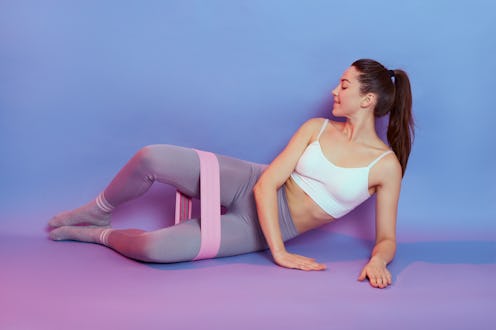Fitness
The Clam Exercise Is The Ultimate Hip Mobility Move
Your guide to the multi-beneficial movement.

The clamshell is one of those exercises that seems a little too easy at first glance. You’re just lying on your side and casually moving your knee up and down, after all. And yet, when you do a clam exercise with good form, it actually packs on the benefits (and the burn).
The clam, or clamshell, is a side-lying exercise that targets the hips, glutes, and thigh muscles, says Judith Houwaard, a Pilates instructor and owner of Amavi Movement. “It was given this name due to the similarities with a clam opening and closing,” she tells Bustle. (Sounds cute... until you do a lot of them.)
Clams are great for improving your hip strength, mobility, and stability, Houwaard says. That’s because the opening and closing movement targets the external rotation of your top hip as it moves your leg bone in the hip socket, she explains. Add clams to your routine often enough, and it can really start to strengthen that area and make you feel more mobile.
Since this exercise focuses on strengthening one side of the body at a time, you actually end up correcting any muscle imbalance you might have in your hips, Houwaard adds, which can decrease body discomfort and lower your risk injury from being out of alignment.
As an added bonus? This movement is also a great way to strengthen the mid glute, which in turn reduces stress and tension in the lower back, Houwaard says. “The gentle activation of the core muscles also assists in this,” she says. Ready to give this simple yet effective exercise a try? Here’s how to do it properly as well as how to modify it.
How To Do The Clam Exercise
Here Jaylee Thomas, a Pilates instructor and owner of RE:MIND Meditation & Movement, explains how to do a clam exercise using good form.
- Lie on a mat on your side with your hips in line with your shoulders.
- Bend your knees and bring your legs to a 70 to 45-degree angle from your body.
- Place your head on your arm or prop it up with a small pillow or towel.
- Make sure your head is not forward or back of the cervical spine.
- Put your hand on the floor in front of your chest for additional stability, or place your hand on your hip to make it more challenging.
- Make sure your hips are stacked and don't let your torso collapse to the floor.
- Engage your deep abdominal muscles, aka the transverse abdominals, to maintain alignment during the movement.
- Inhale to prepare. On the exhale, keep your toes together as you rotate at the hip joint and open the knees. Think of leading the movement with your top knee, like the opening of a clam shell.
- Rotate your top knee open but only as far as you can without losing your hip alignment.
- Return on the inhale and repeat.
- Do 10 to 12 reps, then repeat on the other side.
How To Modify The Clam
To make this move a little more challenging, Thomas recommends adding a resistance band to your quads to create more tension as you lift and lower your knees. For even more of a burn, add another resistance band around your ankles.
Have an exercise ball handy? “Another great way to shake it up is to add a small exercise ball between the knees or a pillow and squeeze it on the down portion of the movement,” Thomas tells Bustle. “This brings in the activation of our inner thigh muscles.”
Common Mistakes To Avoid
As with any exercise, it’s important to pay attention to your form the entire time in order to make the most of the move. Thomas warns against letting your torso tip forward as you lift and lower your top leg.
“To avoid this, focus on maintaining the same distance between your ribs and hip bones,” she says. “You can do this by placing your thumb on your lower rib and your middle finger on your hip bones to gauge any change.”
You also don’t want your hips to roll forward. Keep your hips, knees, and feet stacked. And last but not least, remember to go slow. “Watch your speed,” says Thomas. “You don't want to see any rocking of the body. You want to use muscle control, not momentum.”
Studies referenced:
McBeth, JM. (2012.) Hip muscle activity during 3 side-lying hip-strengthening exercises in distance runners. J Athl Train. doi: 10.4085/1062-6050-47.1.15.
Sidorkewicz, N. (2014.) Examining the effects of altering hip orientation on gluteus medius and tensor fascae latae interplay during common non-weight-bearing hip rehabilitation exercises. Clin Biomech (Bristol, Avon). doi: 10.1016/j.clinbiomech.2014.09.002.
Willcox, E. (2013). The Influence of Varying Hip Angle and Pelvis Position on Muscle Recruitment Patterns of the Hip Abductor Muscles During the Clam Exercise. https://www.jospt.org/doi/10.2519/jospt.2013.4004
Sources:
Judith Houwaard, Pilates instructor, owner of Amavi Movement
Jaylee Thomas, Pilates instructor, owner of RE:MIND Meditation & Movement